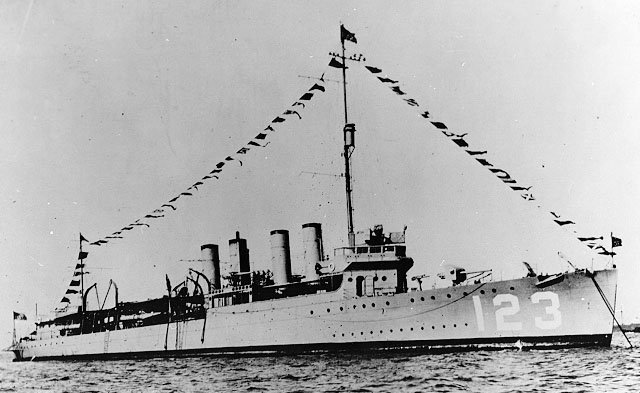

|
|
USS Gamble (DD 123) found in USS Helena CL-50 War Diary for 16 August 1942, CLASS - WICKES (LAMBERTON)
Operational and Building Data
On 7 December 1941, Gamble had returned from offshore patrol, when her peaceful Sunday morning
On 27 August 1942, Gamble joined a task unit headed to Guadalcanal. Although designated a destroyer-minelayer,
Five minutes after midnight, 6 May 1943, Gamble, with Preble and Breese, turned simultaneously in rain squalls which

USS Gamble (DD 123) was named jointly in honor of two brothers, heroes of the War of 1812.
Lt. Peter Gamble, was born in Bordentown, N.J.; appointed midshipman 16 January 1809;
served on Macdonough's flagship Saratoga in the Battle of Lake Champlain, being killed in
action while in the act of sighting his gun 11 September 1814. Macdonough deplored his loss
and commended his gallantry in action. Lt. Col. John M. Gamble, USMC, was born in Brooklyn,
N.T., in 1791; appointed 2d Lt. 16 January 1809; and distinguished himself by coolness and
bravery in many enterprises, including critical encounters with hostile natives of the Marquesa
Islands during the absence of frigate Essex in 1813, and sailing a prize of Essex, with only a
four-man crew and without benefit of a chart in a remarkable 17-day voyage to the Hawaiian Islands.
He was breveted a Lt. Col. 3 March 1827 and died in New York 11 September 1836.
Built to Bath plans, built by Newport News, these Wickes versions were
slightly heavier but had a good cruising radius.
Displacement 1,213 Tons, Dimensions, 314' 5" (oa) x 31' 8" x 9' 10" (Max)
Armament 4 x 4"/50, 2 x 3"/23AA, 12 x 21" tt.
.
Machinery, 24,900 SHP; Direct Drive Turbines with Geared Cruising Turbines, 2 screws
Speed, 35 Knots, Crew 101.
Laid down by Newport News Shipbuilding on November 12 1917.
Launched May 11 1918 and commissioned November 29 1918.
Decommissioned at San Diego June 17 1922 and was berthed there until
recommissioning on May 24 1930.
Reclassified Light Minelayer DM-15 June 13 1930.
Fate Gamble was irreparably damaged by Japanese aircraft off Iwo Jima
February 17 1945 and scuttled off Guam July 16 1945.
5 of her crew were lost and remain on duty.
routine was broken by the first of the Japanese carrier-based planes which pounded American ships
in the harbor. Gamble's gunners joined the fire of other warships and saw one enemy plane fall into the
water on her port beam. After the attack she took antisubmarine patrol station in the screen of Enterprise,
and later guarded the approaches to Pearl Harbor. In mid-February 1942, she headed south in the escort
for a convoy to Pago Pago, Samoa, then joined Ramsey in laying a protective mine field off Tutuila . At the
end of March the two minelayers shifted to the Fiji Islands, to lay a minefield in Nadi waters 7-14 April.
Returning to Pearl Harbor for heavier armament, Gamble helped safeguard convoys to Midway during the
time of that crucial and historic battle, then headed south with Breese and Tracy to lay a defensive mine
field off the entrance to Second Channel, Espiritu Santo, New Hebrides Islands.
the old four-piper still carried antisubmarine gear. On the morning of 29 August, when her lookouts spotted a large
enemy submarine, she immediately went into action. After several depth charge attacks, Gamble ran through large
oil slicks, found deck planking, and observed a large air bubble break the surface. Later her victim was identified as
I-123, whose dying radio had signaled "under heavy enemy attack." That afternoon she proceeded at full speed to
Nura Island where she rescued four stranded aviators from Saratoga. Continuing to aid in the struggle for Guadalcanal,
she transported 158 Marines to the island 31 August, patrolled off Lunga Roads, then on 5 September assisted in freeing
William Ward Burrows and escorted her to Espiritu Santo, New Hebrides Islands. Her patrol, escort, and transport duty
continued as the drive for Guadalcanal pressed on to victory.
broke at times to disclose each to the other in perfect formation. Making 15 kn (28 km/h), each ship dropped a mine every
12 seconds, planting over 250 mines in 17 minutes across Blackett Strait, the western entrance to Kula Gulf and directly in
the favorite route of the worrisome "Tokyo Express." The ships then sped north to join the protective screen of Rear Admiral
Walden L. Ainsworth's cruiser-destroyer force before refueling at Tulagi. On the night of 7/8 May, four Japanese destroyers
entered the mined waters. One, Kuroshio, went down, two others, Oyashio and Kagero, were badly damaged and sent out
calls for help that brought Michishio to the scene. Aircraft, alerted by a coastwatcher, intercepted the rescue operation, sinking
the two destroyers and sending Michishio limping back to port, badly damaged.